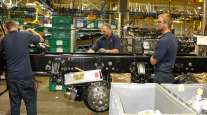Volvo: Too Tough GHG Rule May Scare Off Truck Buyers

This story appears in the May 16 print edition of Transport Topics.
DUBLIN, Va. — Volvo Trucks North America is laboring diligently to persuade federal and state regulators to ramp up standards on greenhouse-gas emissions in an orderly fashion so as not to scare off fleets from buying more fuel-efficient trucks that will be produced to comply with the Phase 2 rule expected later this year.
The company’s top executives told reporters here May 11 they are “doing a lot of lobbying to address the challenges and benefits” associated with the GHG proposal.
VTNA President Göran Nyberg said the lobbying is important because a mandate that is too aggressive could cause a pre-buy sales boom in 2019 and 2020 before Phase 2 takes effect, and then a sales bust in 2021 as fleets try to avoid the new anti-carbon dioxide controls.
“It’s nice to have a peak record for sales, but then it becomes very cold,” Nyberg said, characterizing the problems with a boom-bust cycle.
Nyberg said VTNA is eager to make more fuel-efficient trucks, but the strategy should be to make vehicles that have market appeal so customers want to “get onboard early and not hold back” on adoption.
Phase 2 of greenhouse-gas regulations aimed at heavy- and medium-duty trucks came out as a joint proposal from the Environmental Protection Agency and National Highway Traffic Safety Administration in June 2015.
Phase 2 will affect truck trailers made in 2018 and trucks in the 2021, 2024 and 2027 model years, requiring them to be more fuel-efficient as a means to emitting less carbon dioxide and other greenhouse gases.
Phase 1 started in January 2014, and the second and final segment of the first phase begins Jan. 1, 2017.
Nyberg also posed some challenges for government regulators, asking them to allow 6x2 powertrain configurations, particularly in Canada; eliminate the requirement for side mirrors; and speed up adoption of platoon and autonomous trucks.
Nyberg’s boss, Claes Nilsson, global president of Volvo Trucks since January, also was at the event at the VTNA truck assembly plant, making his first appearance here in his new position.
Nilsson said he thinks autonomous trucks will be sold commercially before platoon vehicles, but they will operate off-road in mining operations. He expects convoys of trucks in platoons will happen on highways before autonomous trucks start operating in large numbers.
VTNA Vice President Magnus Koeck said Volvo is supplying trucks for a University of California- Berkeley experiment in June that will be conducted near San Jose in conjunction with Peloton Technology, a major developer of platoon technology.
Volvo is a major proponent of 6x2 configurations, in which a tractor has only one powered axle. The more common 6x4 arrangement has two tractor axles that get power.
Nyberg said 6x2s are more fuel- efficient and should be allowed throughout the United States and Canada, a nation whose regulators have been skeptical of their safety. Nyberg said he thinks he can persuade them to change.
As for side mirrors, he called them “big and chunky” and said cameras do a better job of providing side and rear vision and are more aerodynamically efficient.
In recent years, VTNA has argued strongly in favor of vertical powertrain integration, urging fleets to outfit their Volvo tractors with Volvo engines and transmissions as well. At the New River Valley plant, though, Nyberg tipped his cap toward independent engine maker Cummins Inc.
“They are a good complement,” he said. “There is definitely room for Cummins. Their longhaul, big-block engine has a place,” he said referring to the ISX 15, the Cummins flagship of truck engines.
Volvo makes 11-, 13- and 16- liter truck engines, but demand for a 15-liter model remains high among operators who run great distances over varied terrain. The Volvo D16 is a specialty heavy-haul or vocational product that is not as efficient, Nyberg said, when used with 80,000-pound vehicles for long highway runs.
Nilsson said Volvo Group CEO Martin Lundstedt was brought on last year to reinvigorate the Gothenburg, Sweden-based manufacturer. The company has made numerous acquisitions over the past 20 years and Lundstedt, Nilsson said, wants to concentrate on brands rather than geography.
As part of that effort, Nilsson went on a five-day, 12-stop, coast-to-coast tour of the United States, meeting with dealers, customers, VTNA personnel and the trucking press.




